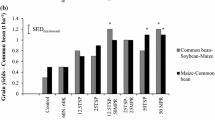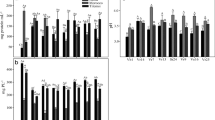Abstract
The Tilemsi phosphate rock (TPR) of Mali is a good and cheaper alternative to imported phosphate fertilizers. Many soil microorganisms can also mobilize sparingly soluble inorganic phosphates, and several have a good potential to improve plant growth. With the aim of improving the response of wheat cultivated in Mali to fertilization with TPR, in this work we describe the isolation and selection from four different Malian soils of TPR-solubilizing microorganisms (TSM) with high P-mobilization activities. When the rhizosphere of three wheat cultivars (Alkama Beri, Hindi Tossom and Tetra) was used to isolate TSM, only bacterial isolates were selected. TPR-solubilizing fungi were only obtained by soil enrichment in liquid medium containing TPR as sole P source. In the rhizosphere a significant correlation was observed between the total microbial population and the number of microorganisms solubilizing TPR. No such correlation was observed in the rhizoplane. Initially 44 bacteria and 18 fungi were selected, but after 10 subcultures on agar plates and a liquid medium, only 6 bacteria and 2 fungi retained their high P solubilizing trait. A field inoculation trial was established during the growing season 2000–2001 in Koygour. Wheat cv. Tetra was inoculated with the 8 selected TSM (6 bacteria and 2 fungi) and fertilized with 30 kg ha−1 P added as TPR or diammonium phosphate (DAP). The growth parameters measured were plant height at 30 and 60 days, the number of leaves per main stem at 60 days, and root and shoot dry matter yields 60 days after planting. Root colonization by indigenous arbuscular mycorrhizas (AM) was also measured in 45-day-old plants. Significant interactions were observed between TSM inoculation and P-fertilization for root colonization with AM, plant height at 30 days and root dry matter yield. The bacterial isolate Pseudomonas sp. BR2, which appeared to be a mycorrhiza helper bacterium, significantly enhanced wheat seedling emergence very early (5 days after planting) under field condition, and caused 128% increase in root dry matter yield. The two TPR-solubilizing fungal isolates Aspergillus awamori Nakazawa C1 and Penicillium chrysogenum Thom C13 also caused respectively 60 and 44% increases in root dry matter yields. The choice of the TSM BR2, C1 and C13 for further field trials is discussed.
Similar content being viewed by others
References
G.N. Al-Karaki (1998) ArticleTitleBenefitcost and water-use efficiency of arbuscular mycorrhizal durum wheat grown under drought stress Mycorrhiza 8 41–45 Occurrence Handle10.1007/s005720050209
Babana A.H. and Antoun H. 2005. Effect of Tilemsi phosphate rock-solubilizing microorganisms on phosphorus uptake and yield of field-grown wheat (Triticum aestivum L.) in Mali. Plant Soil: in press.
A.W. Bakker B. Schippers (1987) ArticleTitleMicrobial cyanide production in the rhizosphere in relation to potato yield reduction and Pseudomonas spp.-mediated plant growth-stimulation Soil Biol. Biochem. 19 451–457 Occurrence Handle10.1016/0038-0717(87)90037-X
J.M. Barea J.L. Escudero C. Azcón-Aguilar (1980) ArticleTitleEffects of introduced and indigenous VA mycorrhizal fungi on nodulation, growth and nutrition of Medicago sativa in phosphate-fixing soils as affected by P-fertilizers Plant Soil 54 283–296 Occurrence Handle10.1007/BF02181854
J.M. Barea R. Azcon C. Azcon-Aguilar (2002) ArticleTitleMycorrhizosphere interactions to improve plant fitness and soil quality Antonie van Leeuwenhoek 81 343–351 Occurrence Handle10.1023/A:1020588701325 Occurrence Handle12448732
A. Bationo E. Ayuk D. Ballo M. Koné (1997) ArticleTitleAgronomic and economic evaluation of Tilemsi phosphate rock in different agroecological zones of Mali Nutrient cycling Agrosyst. 48 179–189 Occurrence Handle10.1023/A:1009784812549
M.D.A. Bolland R.J. Gilkes (1997) ArticleTitleThe agronomic effectiveness of reactive phosphate rocks. 2. Effect of phosphate rock reactivity Aust. J. Exp. Agric. 37 937–946 Occurrence Handle10.1071/EA96109
J.M. Bric R.M. Bostock S.E. Silverstone (1991) ArticleTitleRapid in situ assay for indoleacetic acid production by bacteria immobilized on nitrocellulose membrane Appl. Environ. Microbiol. 57 535–538
R. Chabot H. Antoun M.P. Cescas (1993) ArticleTitleStimulation de la croissance du maïs et de la laitue romaine par des microorganismes dissolvant le phosphore inorganique Can. J. Microbiol. 39 941–947
R. Chabot H. Antoun M.P. Cescas (1996) ArticleTitleGrowth promotion of maize and lettuce by phosphate-solubilizing Rhizobium leguminosarum biovar phaseoli Plant Soil 184 311–321
J.R. Freitas ParticleDe J.J. Germida (1990) ArticleTitlePlant growth promoting rhizobacteria for winter wheat Can. J. Microbiol. 36 264–272
J.R. Freitas ParticleDe M.R. Banerjee J.J. Germida (1997) ArticleTitlePhosphate-solubilizing rhizobacteria enhance the growth and yield but not phosphorus uptake of canola (Brassica napus L.) Biol. Fertil. Soils. 24 358–364 Occurrence Handle10.1007/s003740050258
J.A. Entry P.T. Rygiewicz L.S. Watrud P.K. Donnelly (2002) ArticleTitleInfluence of adverse soil conditions on the formation and function of arbuscular mycorrhizas Adv. Environ. Res. 7 123–138 Occurrence Handle10.1016/S1093-0191(01)00109-5
S. Gagné H. Antoun C. Richard (1985) ArticleTitleInhibition des champignons phytopathogènes par des bactéries isolées du sol et de la rhizosphère de légumineuses Can. J. Microbiol. 31 856–860
P.T. Gaines A.G. Mitchell (1979) Chemical methods for Soil and Plant Analysis University of Georgia Coastal Plain Station, Tifton, USA 105
J.J. Germida F.L. Walley (1996) ArticleTitlePlant growth-promoting rhizobacteria alter rooting patterns and arbuscular mycorrhizal fungi colonization of field-grown spring wheat Biol. Fert. Soils 23 113–120
A.H. Goldstein (1986) ArticleTitleBacterial solubilization of mineral phosphate: historical perspective and future prospects Am. J. Altern. Agric. 1 51–57
J.H. Graham L.K. Abbott (2000) ArticleTitleWheat responses to aggressive and non-aggressive arbuscular mycorrhizal fungi Plant Soil 220 207–218 Occurrence Handle10.1023/A:1004709209009
P. Gyaneshwar G.L. Naresh Kumar J. Parekh P.S. Poole (2002) ArticleTitleRole of soil microorganisms in improving P nutrition of plants Plant Soil 245 83–93 Occurrence Handle10.1023/A:1020663916259
A.C. Kennedy (1999) The Rhizosphere and the spermosphere D.M. Sylvia J.J. Fuhrmann P.G. Hartel D.A. Zuberer (Eds) Principles and Applications of Soil Microbiology Prentice Hall Toronto 389–407
O.G.G. Knox K. Killham C.E. Mullins M.J. Wilson (2003) ArticleTitleNematode-enhanced microbial colonization of the wheat rhizosphere FEMS Microbiol. Let. 225 227–233 Occurrence Handle10.1016/S0378-1097(03)00517-2
E.C. Large (1954) ArticleTitleGrowth stages in cereals: illustration of the Feekes scale Plant Pathol. 3 128–129
J.A. McKeague (Eds) (1978) Manual of Soil Sampling and Methods of Analysis Canadian Soil Survey Committee Canadian Society of Soil Science Ottawa 223
A. Mehlich (1984) ArticleTitleMehlich 3 soil test extractant: a modification of Mehlich 2 extractant Commun. Soil Sci. Plant Anal. 15 1409–1416
A.M.F. Milagres A. Machuca D. Napoleao (1999) ArticleTitleDetection of siderophore production from several fungi and bacteria by a modification of chrome azurol S (CAS) agar plate assay J. Microbiol. Methods 37 1–6 Occurrence Handle10.1016/S0167-7012(99)00028-7 Occurrence Handle10395458
C.S. Nautiyal (1999) ArticleTitleAn efficient microbiological growth medium for screening phosphate solubilizing microorganisms FEMS Microbiol. Lett. 170 265–270 Occurrence Handle10.1016/S0378-1097(98)00555-2 Occurrence Handle9919677
I. Reyes L. Bernier H. Antoun (2002) ArticleTitleRock phosphate solubilization and colonization of maize rhizosphere by wild and genetically modified strains of Penicillium rugulosum Microb. Ecol. 44 39–48 Occurrence Handle10.1007/s00248-002-1001-8 Occurrence Handle12019460
A.E. Richardson (2001) ArticleTitleProspects for using soil microorganisms to improve the acquisition of phosphorus by plants Aust. J. Plant Physiol. 28 897–906
H. Rodriguez R. Fraga (1999) ArticleTitlePhosphate solubilizing bacteria and their role in plant growth promotion Biotechnol. Adv. 17 319–339 Occurrence Handle10.1016/S0734-9750(99)00014-2 Occurrence Handle14538133
InstitutionalAuthorNameSAS, Institute Inc (1990) SAS procedure guide version 6 edition SAS Institute Inc CarNC 705
F.M. Scher J.S. Zieglle J.W. Klopper (1984) ArticleTitleA method for assessing the root-colonizing capacity of bacteria on maize Can. J. Microbiol. 30 151–157
R.G.D. Steel J.H. Torrie (1980) Principles and procedures of statistics, a biometrical approach MacGraw-Hill Book Co New York
H.L.S. Tandon M.P. Cescas E.H. Tyner (1968) ArticleTitleAn acid-free vanadate-molybdate reagent for the determination of total phosphorus in soils Soil Sci. Soc. Am. Proc. 32 48–51
H. Vierheilig A.P. Goughlan U. Wyss Y. Piché (1998) ArticleTitleInk and vinegara simple technique for arbuscular-mycorrhizal fungi Appl. Environ. Microbiol. 64 5004–5007 Occurrence Handle9835596
Author information
Authors and Affiliations
Corresponding author
Additional information
An erratum to this article is available at http://dx.doi.org/10.1007/s10705-006-9067-1.
Rights and permissions
About this article
Cite this article
Babana, A.H., Antoun, H. Biological System for Improving the Availability of Tilemsi Phosphate Rock for Wheat (Triticum aestivum L.) Cultivated in Mali. Nutr Cycl Agroecosyst 72, 147–157 (2005). https://doi.org/10.1007/s10705-005-0241-7
Received:
Accepted:
Issue Date:
DOI: https://doi.org/10.1007/s10705-005-0241-7




